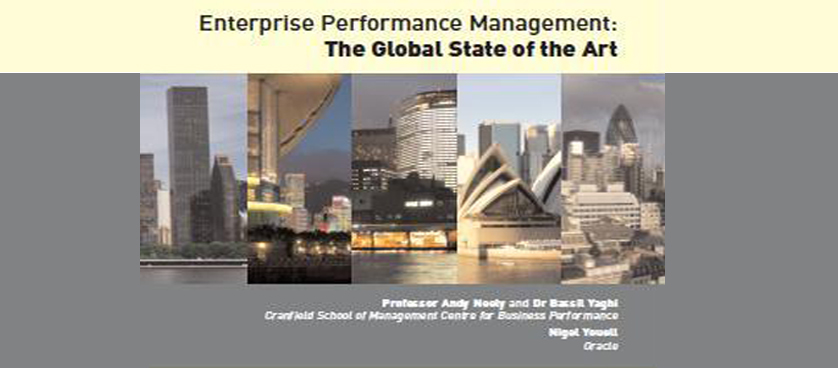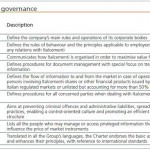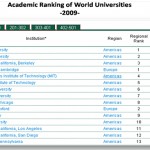Enterprise Performance Management – State of the art
Performance Management is one of the most dynamic business disciplines today. Its evolution accelerated over the last 20 years and due to the large number of concepts it employs and unstructured body of knowledge, having a comprehensive view of the current state of its evolution is rather challenging. One way of achieving this is by monitoring the pulse of the discipline as reflected in studies and survey reports covering performance management topics (Brudan, 2010).
Such a report is the “Enterprise Performance Management – State of the Art” study. Conducted in 2007 by Professor Andy Neely (Cambridge University and Cranfield School of Management) and its fellow colleagues and collaborators, the report presents data gathered from 633 companies in five separate countries: Australia, China, Japan, USA and UK on aspects that revolve round the appropriate design and implementation of enterprise performance management systems in organizations.
Listed below is a random list of relevant statistics published in the final reports, grouped for each country, but also aggregated overall in a global report.
Global Market- “….financial measures still dominate. In every country, financial measures are the most frequently measured and over half of those surveyed report that over 50% of their measures are financial”
- ” …..40% of those surveyed do not think that their performance measures are based on good quality data.”
- “…the spreadsheet is the most widely used performance management application by some distance.”
- “… enterprise performance management systems are seen to have the biggest impact on operational performance and key performance indicators and less impact on strategic performance…”
- ” In four of the five countries we studied (the exception being Japan) senior management was listed as the primary audience for measurement data……..the level of advocacy for measurement decreased the further down the organizational hierarchy we went..”
- “… 89% reported that they had adopted a formal structure for their enterprise performance management system.”
- ” The balanced scorecard is particularly popular with 67% of firms reporting that they used this.”
- “… an overwhelming 73.2% of respondents either have incomplete or partial understanding of cause and effect relationship in their companies. Perhaps because, 45.9% make no effort to visualize the links between their measures.”
- ” 59% of respondents claimed that they gained insight from their enterprise performance management systems…”
- ” 60% said that their enterprise performance management systems helped them make better strategic and operational decisions.”
Japanese Market
- “According to data over 60% of Japanese companies have now adopted performance management frameworks such as the balanced scorecard.”
- ” Only 43% of the respondents attribute part of their companies’ overall business performance to their enterprise performance management activities and only 35% report gaining insight from their enterprise performance management information.”
- “…less than 50% of people report that they have the right number of measures in their organizations. 44% report they have too few measures, while 16% report that they have too many.”
- “…relatively few organizations look outside to understand and adopt good practice in enterprise performance management. 81% of respondents develop their solutions internally.”
- ” 73% report that they use spreadsheets, while only 20% claim to use enterprise performance management solutions.”
- ” The most popular performance measurement framework is the balanced scorecard. 54.7% of the respondents report that they have adopted this methodology.”
- “… 68.7% of respondents agree or strongly agree that the performance measures they use now reflect their strategies.”
- ” 61.4% of respondents agree or strongly agree that improvements in company performance can be attributed to enterprise performance management.”
- ” … only 17.3% believe they have the right number of measures, while 38.6% have concerns about the quality of their data.”
- “… 43.2% of respondents report that more than half of the measures they monitor are financial in orientation.”
- ” Reflecting the popularity of the balanced scorecard as a framework for guiding the design of enterprise performance management systems, 48.8% of respondents claim to have one in place…”
- ” The majority of the respondents, 65.4%, report that their KPIs are based on quality data”….with 63.5% of the respondents reporting that ” their KPIs clearly and accurately measure their business.”
- ” Despite the abundant literature on mapping strategies, the majority of the respondents, 62%, do not visualize their strategies…only 5.7% of the respondents report using strategy maps to structure their indicators“
- ” … 68.7% of respondents report that their performance indicators reflect their strategy”
- “… 74.6 % of the organizations have taken an in-house approach to developing their enterprise performance management systems.”
- “…65.5% of the respondents claim to have a balanced scorecard….. no other framework for enterprise performance management design being prominent in Australia, with 39.3% of respondents preferring to use their own basis for designing their enterprise performance management system.”
- ” Irrespective of framework utilized, the majority of respondents, 70%, have attempted to ensure that the KPIs selected reflect their business strategy.”
- ” 58.8% of respondents agree or strongly agree that their enterprise performance management (EPM) system contributes to improvements in company performance.”
- ” 53.7% of respondents report that more than half of their KPIs are financial measures“
- ” Enhancements to operational decision-making were reported by the most respondents, 81.9%, followed closely by improvements in the KPIs themselves, 77.5%”
As the final Global State of the Art report (2008) reveals, organizations from around the world continue to redesign how they measure their business performance, struggling to capitalize on the full value of enterprise performance management.
References:

Tags: Performance in Australia, Performance in China, Performance in Japan, Performance in UK, Performance in USA, Report Analysis






